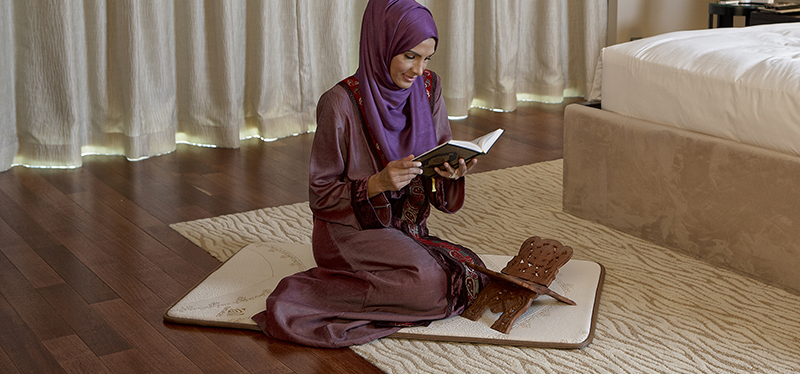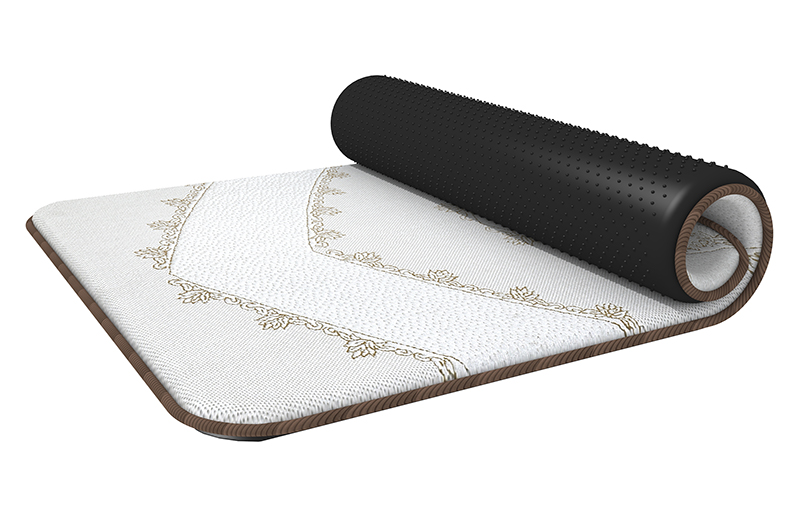
Antimicrobial Agent Updates Ancient Industry of Prayer Mats
NASA Technology
Although it is one of the most abundant organic compounds on Earth, chitin is not among the best understood. For example, chitosan, a derivative of chitin, has been used in agriculture since the 1980s and is credited with boosting plant immunity, increasing resistance to insects and fungi, stimulating nutrient uptake and germination, reducing fruit and vegetable decay, and protecting against freezing. In humans, it has been said to battle obesity and high cholesterol, increase immunity, prevent cavities, and speed blood coagulation.
Not all these benefits have been proven, but NASA, particularly interested in the potential for hardier crops and augmented human immunity, has investigated chitosan and demonstrated at least a couple of its benefits.
A nitrogen-containing polysaccharide, chitin is the primary ingredient in the exoskeletons of arthropods, such as insects, spiders, and crustaceans, and possibly doubles as a first line of defense in these organisms’ immune systems. Its molecules carry a positive charge that attracts the negatively charged membranes of bacteria, trapping and possibly killing them, and also initiates red blood cell clotting.
In 1997, NASA researchers aboard the Mir Space Station and the Space Shuttle used chitosan to protect adzuki bean plants and found the treated plants yielded more biomass and showed greater resistance to pathogens than the control group. With an eye toward long-term, deep-space exploration, the Agency has had an interest in space farming since its inception. Aboard a spacecraft, plants not only provide food but, as they do on Earth, also filter carbon dioxide from the air, replacing it with oxygen, and they can process and eliminate waste by feeding on it.
The researchers found that chitosan increased levels of beta-1, 3 glucanase enzymes in their bean plants’ cells, making them more resistant to fungal pathogens, and they determined the substance would have the same effect on Earth.
Ten years later, Johnson Space Center, in collaboration with the Department of Defense, undertook an experiment on NASA’s Cell Culture Module aboard the International Space Station (ISS) to determine chitosan’s effects on human immunity.
Previous studies had shown many bacteria become more virulent in microgravity, where it is easier for some types to spread out and minimize competition for resources, and where they can more easily form hardy biofilms. Some even express their genes differently and become more infectious. Meanwhile, for reasons not completely understood, the human immune system is weakened during spaceflight. NASA’s interest in boosting it was clear.
Results of the 2007 study on the ISS were also unambiguous. Human white blood cells—the warriors of the immune system—injected with both an endotoxin and chitosan-arginine survived the trip and made it back to Earth, while those injected only with the endotoxin were wiped out.
Technology Transfer
The ISS experiment on white blood cells took place right about the time Nader Sabry and his crew began research that would result in the first significant update to an ancient industry—prayer mats.
“We did a lot of research into antimicrobial agents and discovered this technology NASA had tested and proven well enough that we decided to look into it,” says Sabry, now the founder and CEO of TIMEZ5 Global Inc., self-proclaimed purveyor of the world’s first physiological prayer mat.
The company brought on Lloyd Starks, now president of Chemco Technologies, as a consultant. In the course of several unrelated partnerships with NASA, Starks had learned of the Agency’s two chitosan studies and seen the report on the ISS work, published by NASA in 2009. He was already working with the Centers for Disease Control (CDC) to use the substance to develop the world’s first antimicrobial film. While chitosan had been used in medicine as a blood coagulant for decades, Starks says, the NASA studies were the first he knew of that demonstrated its effectiveness as an antimicrobial agent.
“NASA identified, tested, and documented it as an antimicrobial, and I took it from there,” he says. In his work with the CDC, he developed a method for using the steam of a chitosan solution to sterilize a surface and form a film that prevents microbes from returning. This technique was used to apply the substance to TIMEZ5’s prayer mats.
The final product, the TIMEZ5 Prayer and Meditation Mat, became available in 2012. The mat has five distinct layers, with chitosan applied to the lowest. Micro-holes that run through the mat let traces of the substance pass through to the surface, keeping all the layers microbe-free, Sabry says. “When you put pressure on it, it will push air through those holes from the bottom upward.”
In the middle of the mat is a thin transfer grid of tiny cones that manage the weight ratio between a weight-absorption layer above and a weight-bearing layer below, both of which are made of a viscoelastic gel foam. The top layer is a microfiber designed to give the surface a soft, pleasant feel, and on the bottom is a micro-grip surface. “Quite a few people have injuries while meditating because their mats move,” Sabry notes.
The surface design, created with the help of a psychologist, is as unorthodox as the rest of the mat, eschewing traditional darker colors and opting instead for tones that better convey “purity and clarity,” Sabry says.
Benefits
In researching its product, the company found that minor respiratory problems are not uncommon among users of prayer mats, a result of dust and tiny organisms that accumulate in them, aided by heat and humidity. Also, Muslims wash before prayer, which can add moisture that fuels the growth of organisms, Sabry says. “Usually these fabrics would collect dust and mold, they would have bacteria and other microbes that collect over time,” he says, adding that he even saw cases of foot fungus possibly contracted from prayer mats.
He says the company settled on chitosan to address these problems after testing showed the substance was able to kill more than 99 percent of the bacteria, fungi, and mold it encountered. The researchers were also impressed by its longevity. “Obviously, it doesn’t last forever, but it works a lot longer than other solutions we looked at,” he says.
Due to the NASA-inspired addition to the design, the TIMEZ5 mat became the first Muslim-oriented product to be recognized by the Space Foundation, which certifies consumer products as having origins in space technology.
While Muslims in the area of the Persian Gulf are the largest segment of the company’s market, TIMEZ5 has customers of all faiths in 35 countries, from Russia to the Americas and especially East Asia, Sabry says. “Our key markets are what we call floor-bound cultures—those who go to the floor to meditate.”
Thanks to its product’s antimicrobial and ergonomic properties, he says, the company has claimed a slice of that industry in the three years or so since its debut and is now selling thousands of mats each month.
TIMEZ5 employs about 125 people in production and about 20 more in operations and research and development. While its headquarters is in Calgary, Alberta, and its international distribution center is in Dubai, the company is working to develop a presence in the United States as well, Sabry says.
He says he’s pleased to have introduced NASA-tested technology to the Middle Eastern culture that produced the first written observations of space. “We used space technology to disrupt an industry that hasn’t innovated in 1,400 years.”

The TIMEZ5 Prayer and Meditation Mat includes layers for weight distribution, comfort, and safety, as well as an antimicrobial layer informed by NASA’s research on chitosan, a derivative of the primary ingredient in the exoskeletons of arthropods, such as insects, spiders, and crustaceans.

Incorporating a NASA-inspired antimicrobial layer, among other features, the TIMEZ5 Prayer and Meditation Mat is the first significant upgrade to the ancient industry of prayer mats.













